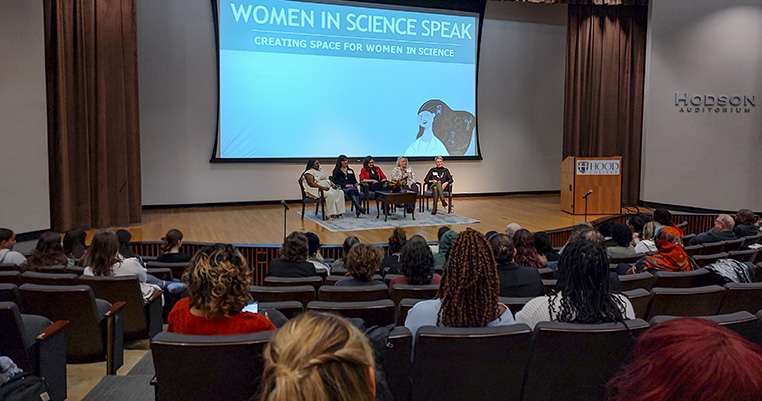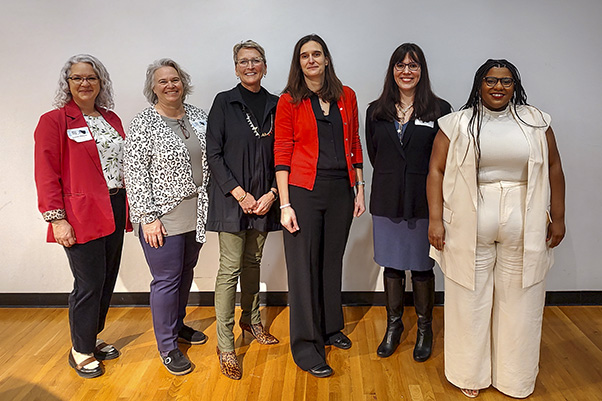There are many paths for women to travel to find success in science.
That was a crucial theme conveyed by the four panelists at Women in Science Speak 2024. The panel marked the International Day of Women and Girls in Science and celebrated empowerment and mentorship among women in science. Woman to Woman Mentoring, Inc.; Frederick National Laboratory; and Hood College co-sponsored the event as part of their missions to mentor students and young professionals.
The panelists, successful women at different stages in their scientific careers, participated in a moderated discussion about their professional journeys. A question-and-answer session and networking session with the approximately 300 attendees followed. The panelists’ stories offered a frank look at the myriad opportunities and obstacles facing women in science.
‘Your Path Is Unique to You,’ Says Boardley
Panelist Angel Boardley, a fourth-year biology student at Hood College, has been accumulating successes. She was named one of Maryland’s Interns of the Month in Science and Technology last year. She’s preparing to join the laboratory of Mary Kearney, Ph.D., a program deputy director at NCI Frederick and chair of the NIH Women Scientists Advisors. She owns a business, and—of course—she’ll graduate from Hood in May.
Getting here wasn’t easy, however.
As a child, she was behind other students her age. She struggled with reading, writing, and math, so much so that some of her teachers gave up on her.
But Boardley was determined. She doubled down and taught herself to read and write better. Her grades soared, and she began passing rigorous courses. After high school, she secured laboratory internships at Johns Hopkins School of Medicine and University of Maryland, Baltimore County.
At 19, she confronted housing insecurity and had to pause her academic pursuits. She worked for months to expand her fledgling business in nannying and family development services and stabilize her income. Before long, she had her own apartment.
Over the following years, Boardley switched between attending college and taking breaks to focus on her business and income as the economy demanded. Yet she also secured more laboratory internships and gained further scientific experience.
“Just because your path doesn’t look like everyone else, that doesn’t matter because your path is unique to you,” she said.
She added that she wrestled with doubt, but now she’s poised to fulfill her dream of a career in science.
“This is what a scientist looks like. Sometimes it isn't easy,” she said. “Having diverse experiences really makes you a diverse and an amazing person.”
Grkovic Sees Value in Discomfort
For panelist Tanja Grkovic, Ph.D., staff scientist in the NCI Molecular Targets Program, success in science involved moving halfway around the world and back again in search of new challenges.
“Change is good. Being uncomfortable and getting used to a new environment is really, really good,” she said.
Her interest in science began with her parents, chemists who loved telling her about their work. Their passion was infectious, and Grkovic developed a keen interest in both biology and chemistry.
She did her undergraduate studies in marine biology in New Zealand but switched to chemistry for her graduate degrees. The decision gave her a foundation to study the intersection between biology and chemistry and unite two fields that fascinated her.
Grkovic obtained her Ph.D. from the University of Auckland, kicking off her two-decade-long career. Her postdoctoral work took her to NCI Frederick in Maryland, then, two years later, to the Griffith Institute for Drug Discovery in Australia. She later returned to Frederick, first as a senior scientist at Frederick National Laboratory, then as a staff scientist in the Molecular Targets Program at NCI Frederick, the same laboratory where she started her postdoctoral work at the beginning of her career.
The expertise she developed by pushing herself in new environments—and the lessons she learned from mentors along the way—have paid off.
Her team is working on the NCI Program for Natural Product Discovery Prefractionated Library, a collection of one million naturally derived compounds with potential uses against disease. So far, they’ve curated about 600,000, substantial progress for such an ambitious project.
“A million fractions is a big number, and I was supposed to be afraid of it, but I wasn’t because I knew that [if] you think hard [and] you work well with your team, you’re going to do it,” she said.
Bray Recalls Finding Direction
Growing up, panelist Terri Bray, a nuclear engineer by training and the director of the Environment, Heath, and Safety Directorate at Frederick National Laboratory, wasn’t certain about a future career path. She wanted to be an engineer but didn’t know what that looked like, she said.
That changed during her third year in college, when she took an internship at Argonne National Laboratory. She found her direction, becoming fascinated with nuclear engineering, and spent the next 22 years at Argonne—a tenure spanning from the early 1990s well into the new millennium.
Despite working most of her career in the same place, she capitalized on opportunities and moved to new roles when she could. She said the frequent challenges were eye-opening and formative.
“It’s really all these different experiences that shaped me, getting me towards where [I wanted] to be,” she said.
In time, Bray became the person who proposed unusual and creative ideas that sparked new ways of thinking and solving problems. Coworkers sought her help on challenging tasks and projects.
In 2013, she brought her decades of expertise to Frederick National Laboratory. There, she has led a large staff of environmental protection specialists, occupational safety professionals, security officers, and medical staff to help steer and support a workforce of nearly 4,000 people at NCI Frederick and Frederick National Laboratory. Her directorate has made numerous improvements in safety and environmental protection practices.
“It is critically important to seek out alternative ideas,” she said, referring to advice she has made a polestar of her career.
Rebecca Kelly: Failure Isn’t the End
To hear panelist Rebecca Kelly speak, one likely wouldn’t think of the words “crash and burn.” Yet that’s exactly what the missions systems engineer at the Johns Hopkins University Applied Physics Laboratory said happened to her.
She had a good start: during her childhood, her parents would walk her to the library every day so she could check out books. Her family encouraged her to find and pursue her passion. These early experiences gave her space to discover her love for science.
From there, learning came naturally and didn’t require much studying—until 2005, her first year of college. Having excelled in school, she expected the same would be true as an undergraduate. It wasn’t.
“I crashed and burned,” she said. “I did not know test scores could get that low.”
It was a humbling experience, but she said she set aside her pride and resolved to meet the challenge head-on. She spent a year retraining herself academically, creating and redeveloping study techniques. Her test scores markedly improved.
Today, she works in spacecraft design and development and has had several successes in various projects, including hands-on flight testing. Her work has been integral to multiple NASA missions.
“How you treat falling down: Do you get back up? Do you fight back? That is what defines you,” she said.
The Next Generation
While the panelists shared advice and addressed challenging topics, perhaps the most telling evidence of their impact came afterward. Young women from local high schools lined up at a microphone to ask questions, the queue reaching halfway to the back of the auditorium. A similar scene played out during the networking session as attendees, mainly students, crowded around to speak with the panelists.
Several were asking for guidance on charting their own careers.
Samuel Lopez leads the editorial team in Scientific Publications, Graphics & Media (SPGM). He writes for newsletters; informally serves as an institutional historian; and edits scientific manuscripts, corporate documents, and sundry other written media. SPGM is the creative services department and hub for editing, illustration, graphic design, formatting, multimedia, and training in these areas.



